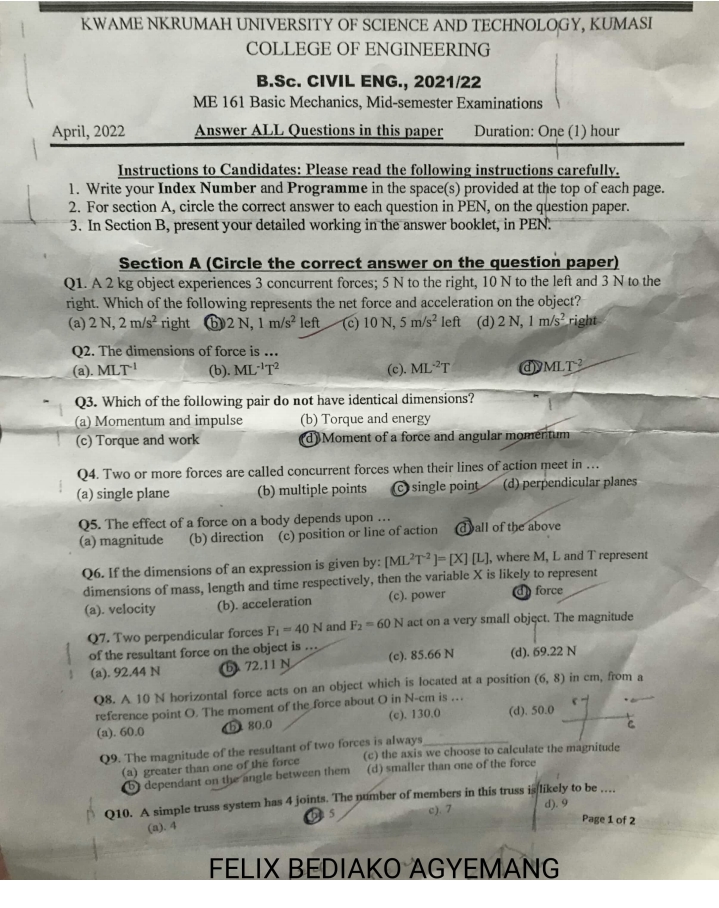Solve the multiple choice questions from the Engineering exam.

Understand the Problem
The image contains a mechanics exam paper with multiple-choice questions. The questions cover topics such as force, dimensions, momentum, torque, concurrent forces, effect of force, resultant force, and truss systems. The student needs to select the correct answer for each question.
Answer
Q1. (b) 2 N, 1 m/s² left Q2. (d) $MLT^{-2}$ Q3. (d) Moment of a force and angular momentum Q4. (c) single point Q5. (d) all of the above Q6. (d) force Q7. (b) 72.11 N Q8. (b) 80.0 Q9. (b) dependant on the angle between them Q10. (b) 5
Answer for screen readers
Q1. (b) 2 N, 1 m/s² left Q2. (d) $MLT^{-2}$ Q3. (d) Moment of a force and angular momentum Q4. (c) single point Q5. (d) all of the above Q6. (d) force Q7. (b) 72.11 N Q8. (b) 80.0 Q9. (b) dependant on the angle between them Q10. (b) 5
Steps to Solve
- Q1: Calculate the net force
First, sum the forces acting to the right: $5 N + 3 N = 8 N$. Then, find the net force by subtracting the force to the left: $8 N - 10 N = -2 N$. The negative sign indicates the net force is to the left.
- Q1: Calculate the acceleration
Use Newton's second law, $F = ma$, to find the acceleration: $a = F/m = -2 N / 2 kg = -1 m/s^2$. The negative sign indicates the acceleration is to the left.
- Q2: Determine the dimensions of force
Force is defined as mass times acceleration ($F=ma$). Mass has dimensions of M, and acceleration has dimensions of $LT^{-2}$. Therefore, the dimensions of force are $MLT^{-2}$.
- Q3: Identify the pair with non-identical dimensions
Momentum is mass times velocity ($mv$), with dimensions $MLT^{-1}$. Impulse is force times time ($Ft$), with dimensions $(MLT^{-2})T = MLT^{-1}$. So, momentum and impulse have the same dimensions. Torque is force times distance ($Fd$), with dimensions $(MLT^{-2})L = ML^2T^{-2}$. Energy and work also have dimensions $ML^2T^{-2}$. Moment of a force is force times distance ($Fd$), with dimensions $(MLT^{-2})L = ML^2T^{-2}$. Angular momentum is $I\omega$, where $I$ is moment of inertia ($MR^2$) and $\omega$ is angular velocity ($T^{-1}$). Thus, angular momentum has dimensions of $ML^2T^{-1}$.
- Q4: Define concurrent forces
Concurrent forces are defined as forces whose lines of action meet at a single point.
- Q5: Determine factors affecting force on a body
The effect of a force depends on its magnitude, its direction, and its line of action (or position).
- Q6: Determine the unknown variable X
Given $[ML^2T^{-2}] = [X][L]$, we need to find $[X]$. Divide both sides by $[L]$: $[X] = [ML^2T^{-2}] / [L] = [MLT^{-2}]$. Since $[MLT^{-2}]$ represents force, X is likely to represent force.
- Q7: Calculate the resultant force
Since the forces are perpendicular, use the Pythagorean theorem to find the magnitude of the resultant force: $R = \sqrt{F_1^2 + F_2^2} = \sqrt{(40 N)^2 + (60 N)^2} = \sqrt{1600 + 3600} = \sqrt{5200} \approx 72.11 N$.
- Q8: Determine that moment of force about O in N-cm
The moment of a force is calculated as the force multiplied by the perpendicular distance from the point of rotation. Given a force $F = 10 N$ acting horizontally at the point $(6, 8)$ cm, the perpendicular distance from the reference point $O$ (0,0) is the y-coordinate, which is $8$ cm. Therefore, the moment $M = F \times d = 10 N \times 8 cm = 80 N \cdot cm$.
- Q9: Magnitude of resultant of two forces
The magnitude of the resultant of two forces depends on the angle between them
- Q10: Number of member is truss system
For a simple truss system, the number of members ($m$) is related to the number of joints ($j$) by the equation: $m = 2j - 3$. In this case, $j = 4$, so $m = 2(4) - 3 = 8 - 3 = 5$.
Q1. (b) 2 N, 1 m/s² left Q2. (d) $MLT^{-2}$ Q3. (d) Moment of a force and angular momentum Q4. (c) single point Q5. (d) all of the above Q6. (d) force Q7. (b) 72.11 N Q8. (b) 80.0 Q9. (b) dependant on the angle between them Q10. (b) 5
More Information
The answers were obtained through application of fundamental principles of mechanics including Newton's laws, dimensional analysis, force calculations and truss analysis.
Tips
Null
AI-generated content may contain errors. Please verify critical information